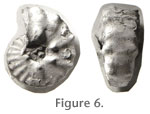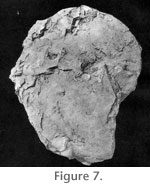| |
INTERPRETING ENCRUSTS ON SHELLS
John (1909) observed that oysters are often found cemented on ammonite shells. Encrusts can also attach to living nautilus shells. In 1972 Professor G. Westermann showed me a specimen of N. pompilius in which the shell had been broken back, thereby exposing an oyster encrusted on the venter of an inner whorl. Hence, the encrustation must have taken place in life and, moreover, in water shallow enough for Ostrea to thrive. Oysters begin life with a pelagic phase of two to three weeks in duration, after which they develop a foot (the pediveliger stage) and then hasten to seek a hard substrate. The oyster paradigm Ostrea edulis inhabits preferentially the subtidal zone, but has been reported to live at depths around 80 m. This natural habitat of this species in the North Sea is placed by
Schäfer (1962, p. 567)
in his Biofazies 7, to wit, 10-20 m.
In the majority of instances, nautiloid encrustations occur in several ways as was reported from the deep-sea expeditions under the leadership of
Carl Chun (1910), who drew attention to the occurrence of drifting nautilus shells overgrown with encrusters of several kinds.
Teichert (1970, p. 1129) recorded two oyster encrustations inside the body chamber of a specimen collected in the Bay of Bengal. Palaeontological studies of encrusted cephalopod shells have been made by
Meischner (1968),
Merkt (1966), and
Schindewolf (1934). Placunopsis ostracina is frequently found as an encrustation on shells of ceratitids.
Geisler (1939)
and
Meischner (1968) showed that this encruster could settle on both living animals as well as drifted shells.
Geisler (1939)
obtained the evidence for the settling of Placunopsis larvae on living Ceratites by systematically breaking back shells as was done by Westermann, referred to above. (NB the taxonomic status of the encrusters of the Triassic, referred to Placunopsis, is uncertain.).
The monograph by
Taylor and Wilson (2003) contains much information on encrusters. With respect to chambered cephalopods, they observe (Taylor and Wilson, 2003, p. 21) that shells of living Nautilus often support zoobiotic communities in which more than 90% of the shells are reported to be colonized in mainly the umbilical region by bryozoans, foraminifers, serpulids and barnacles. Drifted shells tend to be more heavily colonized and with the organisms more randomly distributed over the shell surface.
 Several examples of encrusting by oysters on shells of species of the Albian genus Knemiceras from Iran and Lebanon have been recorded by W.J. Kennedy and myself. These are Several examples of encrusting by oysters on shells of species of the Albian genus Knemiceras from Iran and Lebanon have been recorded by W.J. Kennedy and myself. These are
1. One or the other of the flanks encrusted, with or without encrusters on the venter.
2. Venter only encrusted.
3. Both flanks fouled with or without encrusting oysters on the venter.
A significant feature of the material concerns the relatively high percentage of encrusted shells. Oysters are denizens of shallow water and it is therefore clear that the encrustation takes place on stranded, and stranding, empty shells, or on shells inhabiting shallow water. Case 1 represents oysters settling on dead shells lying near to the strandline and within the living range of oysters.
 Case 2 and Case 3 indicate fouling of floating ammonite shells by oysters. A specimen of Knemiceras from Iran bearing oysters on its venter and lateral flank is illustrated in
Figure 6. A specimen of the early Turonian species Wrightoceras wallsi, from the Gombe area of Northern Nigeria, shown in
Figure 7, bears numerous encrusting Ostrea olisiponensis from more than one infestation. The specimen appears to have ended up on its side in shallow water. Heavily fouled floating shells of the pearly nautilus have been recorded by
Jokiel (1989) and also by
Castillo and Guiņez (2000) with encrusts of coral, algae, oysters, barnacles, bryozoans and other organisms. Jokiel used his data to illustrate the geographical spread of organisms by rafting, that is, their being dispersed passively attached to floating objects.
House (1987) cites an example for N. scrobiculatus.
Westermann and Tsujita (1999, pp. 310-311) also made a clear statement of the roll of the nekroplanktonic factor in the dispersal of ammonites. Case 2 and Case 3 indicate fouling of floating ammonite shells by oysters. A specimen of Knemiceras from Iran bearing oysters on its venter and lateral flank is illustrated in
Figure 6. A specimen of the early Turonian species Wrightoceras wallsi, from the Gombe area of Northern Nigeria, shown in
Figure 7, bears numerous encrusting Ostrea olisiponensis from more than one infestation. The specimen appears to have ended up on its side in shallow water. Heavily fouled floating shells of the pearly nautilus have been recorded by
Jokiel (1989) and also by
Castillo and Guiņez (2000) with encrusts of coral, algae, oysters, barnacles, bryozoans and other organisms. Jokiel used his data to illustrate the geographical spread of organisms by rafting, that is, their being dispersed passively attached to floating objects.
House (1987) cites an example for N. scrobiculatus.
Westermann and Tsujita (1999, pp. 310-311) also made a clear statement of the roll of the nekroplanktonic factor in the dispersal of ammonites.
|